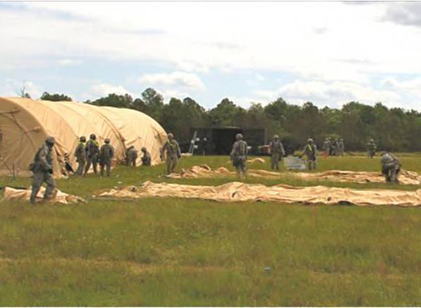Air Beam Shelter Near Reality
Can the time it currently takes to deploy a Combat Support Hospital during combat conditions be done twice as fast and with fewer personnel? This is close to becoming a reality.
The Force Provider Expeditionary-Medical Systems air beam shelters were assessed as usable and functional in the medical operational environment, after the U.S. Army Medical Department Test Board evaluated the shelters in April 2012 at Fort Benning, Ga. Soldiers who participated preferred the air beam shelters because they were easily set up with only a few people, were easy to keep clean, and offered good ventilation and ceiling height.
As quoted in Vince Little's article published in the April 2013 edition of The Bayonet, Maj. Jeffery Hogue, executive officer of the 14th CSH, said, "The new system we're using here goes up a lot faster. It takes a lot less people, and it is essentially a little safer as well."
Under a Congressional Special Interest project, the U.S. Army Medical Materiel Development Activity's Medical Support Systems Project Management Office developed the air beam shelters, which were adopted by the Product Manager Force Sustainment Systems as a replacement for the 25-year-old tent, extendable, modular, personnel, or TEMPER, soft-walled shelters in the current Deployable Medical Systems family of medical shelters.
The AMEDD Test Board coordinated the Fort Benning event with MSS PMO and the 14th CSH to evaluate how the new shelter supports the medical mission. MSS PMO coordinated with U.S. Army Natick Soldier Research, Development, and Engineering Center; Directorate of Combat and Doctrine Development; U.S. Army Medical Materiel Agency; PdM Force Sustainment Systems; Project Manager, Mobile Electric Power; and Communications-Electronics Research, Development and Engineering Center to ensure all the assets and training were in place for a successful customer assessment. CERDEC's Army Power Division conducted a real-time power assessment for the 84-bed CSH.
The 14th CSH provided the 84-bed hospital company and support to assist the AMEDD Test Board in determining the suitability of the air-beam shelter as a hospital under field conditions. The assessment included pack out, set up of 33 shelters, establishment in sequence, collective protection, or COLPRO, assessment of three wards with one bump-through door airlock, and simulated medical, surgical, nursing, and ancillary services.
NSRDEC trained Soldiers on setting up and using the shelters and the chemically protected DEPMEDS, as well as air beam and integration training.
"It's been pretty realistic," Hogue said in the Bayonet article. "The training itself is beneficial since the AMEDD team gets to see a unit work in a chemical-protected hospital. The new tent is easier and goes up faster. Less people are required to put it up. â?¦What results is you have quicker medicine on the battlefield."
The goal of the CP DEPMEDS is to provide COLPRO from chemical and biological agents while medical and surgical functions continue. The FPE-MS shelter uses a COLPRO removable thermal liner. Also, environmental control units maintain airflow and temperature for 72 hours and are hardened to resist chemical and biological agents.
FPE-MS uses four high-pressure (40 psi), air-filled arches to support the shelters, drastically reducing the weight of the structure and shortening set-up time with fewer personnel. The basic shelter module's interior measurements are 32 feet long by 20 feet wide by 10 feet high, and has 640 square feet of clear-span floor area. The shelter weighs 600 pounds and is 106 cubic feet, packed in a lightweight cargo net.
Models are available in several configurations, depending on the mission. Three adjoining 64-foot FPE-MS air beam shelters, each comprised of two shelter modules, were configured during the assessment as an emergency medical triage area, central materiel supply and intensive care unit, which were connected using vestibules.
The 64-foot air beam shelter weighs 1,200 pounds. The customer assessment showed that eight Soldiers set up the 64-foot air beam shelter and installed the liner in less than two hours. In contrast, the similar size TEMPER shelters weigh 3,977 pounds and require 10-12 Soldiers to set them up in approximately 6 hours.
According to Jaime Lee, MSS PMO product manager, some modifications are being made as a result of the assessment. The manufacturer replaced 50 shelter skins due to a defect in the material provided by a sub-vendor. Windows were added to increase ventilation and lighting, and alternative flooring will be considered. The shelter skins were tested again in March 2013 in cooperation with NSRDEC and the manufacturer to verify the skins that were replaced with original specified materials and windows addressed the issues found by the AMEDD Test Board . If senior leadership decides the air beam shelters are functional and affordable, they will be re-tested by the AMEDD Test Board in fiscal year 2014 or 2015, with plans to field in fiscal year 2016.
On the last day of the test event, senior leadership from U.S. Army Medical Research and Materiel Command visited the site. The system was well received, and support for the program continues.
The shelters were tested previously in 2010 at Camp Bullis near Fort Sam Houston, Texas, and are deployed in support of Operation Enduring Freedom as Rest and Relaxation base camps. The shelters were also tested during Operation Iraqi Freedom operations.















